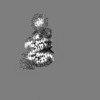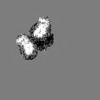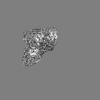[English] 日本語
 Yorodumi
Yorodumi- EMDB-48514: Cryo-EM structure of VCP/p97 and VCPIP1 (VCIP135) in the presence... -
+ Open data
Open data
- Basic information
Basic information
| Entry |  | |||||||||
|---|---|---|---|---|---|---|---|---|---|---|
| Title | Cryo-EM structure of VCP/p97 and VCPIP1 (VCIP135) in the presence of AMPPNP | |||||||||
 Map data Map data | Structure of VCP/p97 and VCPIP1 (VCIP135) in the presence of AMPPNP | |||||||||
 Sample Sample |
| |||||||||
 Keywords Keywords | ATPase / unfoldase / deubiquitinase / HYDROLASE | |||||||||
| Function / homology |  Function and homology information Function and homology informationprotein K11-linked deubiquitination / endoplasmic reticulum membrane fusion / Golgi reassembly / protein K48-linked deubiquitination / : / flavin adenine dinucleotide catabolic process / VCP-NSFL1C complex / endosome to lysosome transport via multivesicular body sorting pathway / endoplasmic reticulum stress-induced pre-emptive quality control / BAT3 complex binding ...protein K11-linked deubiquitination / endoplasmic reticulum membrane fusion / Golgi reassembly / protein K48-linked deubiquitination / : / flavin adenine dinucleotide catabolic process / VCP-NSFL1C complex / endosome to lysosome transport via multivesicular body sorting pathway / endoplasmic reticulum stress-induced pre-emptive quality control / BAT3 complex binding / cellular response to arsenite ion / protein-DNA covalent cross-linking repair / Derlin-1 retrotranslocation complex / positive regulation of protein K63-linked deubiquitination / cytoplasm protein quality control / positive regulation of oxidative phosphorylation / : / Golgi stack / aggresome assembly / deubiquitinase activator activity / mitotic spindle disassembly / ubiquitin-modified protein reader activity / regulation of protein localization to chromatin / VCP-NPL4-UFD1 AAA ATPase complex / cellular response to misfolded protein / negative regulation of protein localization to chromatin / positive regulation of mitochondrial membrane potential / vesicle-fusing ATPase / K48-linked polyubiquitin modification-dependent protein binding / regulation of aerobic respiration / retrograde protein transport, ER to cytosol / stress granule disassembly / ATPase complex / regulation of synapse organization / ubiquitin-specific protease binding / positive regulation of ATP biosynthetic process / MHC class I protein binding / ubiquitin-like protein ligase binding / RHOH GTPase cycle / polyubiquitin modification-dependent protein binding / protein deubiquitination / autophagosome maturation / negative regulation of hippo signaling / endoplasmic reticulum to Golgi vesicle-mediated transport / HSF1 activation / translesion synthesis / interstrand cross-link repair / ATP metabolic process / endoplasmic reticulum unfolded protein response / proteasomal protein catabolic process / Protein methylation / Attachment and Entry / ERAD pathway / lipid droplet / proteasome complex / viral genome replication / Josephin domain DUBs / N-glycan trimming in the ER and Calnexin/Calreticulin cycle / negative regulation of smoothened signaling pathway / macroautophagy / positive regulation of protein-containing complex assembly / Hh mutants are degraded by ERAD / establishment of protein localization / Hedgehog ligand biogenesis / Defective CFTR causes cystic fibrosis / positive regulation of non-canonical NF-kappaB signal transduction / Translesion Synthesis by POLH / ADP binding / ABC-family proteins mediated transport / autophagy / cytoplasmic stress granule / Aggrephagy / positive regulation of protein catabolic process / azurophil granule lumen / KEAP1-NFE2L2 pathway / Ovarian tumor domain proteases / positive regulation of canonical Wnt signaling pathway / positive regulation of proteasomal ubiquitin-dependent protein catabolic process / double-strand break repair / E3 ubiquitin ligases ubiquitinate target proteins / site of double-strand break / cellular response to heat / Neddylation / ubiquitin-dependent protein catabolic process / secretory granule lumen / protein phosphatase binding / regulation of apoptotic process / ficolin-1-rich granule lumen / proteasome-mediated ubiquitin-dependent protein catabolic process / ubiquitinyl hydrolase 1 / Attachment and Entry / cysteine-type deubiquitinase activity / protein ubiquitination / ciliary basal body / endoplasmic reticulum lumen / protein domain specific binding / DNA repair / intracellular membrane-bounded organelle / DNA damage response / ubiquitin protein ligase binding Similarity search - Function | |||||||||
| Biological species |  Homo sapiens (human) Homo sapiens (human) | |||||||||
| Method | single particle reconstruction / cryo EM / Resolution: 3.3 Å | |||||||||
 Authors Authors | Vostal LE / Kapoor TM | |||||||||
| Funding support |  United States, 1 items United States, 1 items
| |||||||||
 Citation Citation |  Journal: J Cell Biol / Year: 2025 Journal: J Cell Biol / Year: 2025Title: Structural insights into the coupling between VCP, an essential unfoldase, and a deubiquitinase. Authors: Lauren E Vostal / Noa E Dahan / Matthew J Reynolds / Lily I Kronenberg / Tarun M Kapoor /  Abstract: Proteostasis involves degradation and recycling of proteins from organelles, membranes, and multiprotein complexes. These processes can depend on protein extraction and unfolding by the essential ...Proteostasis involves degradation and recycling of proteins from organelles, membranes, and multiprotein complexes. These processes can depend on protein extraction and unfolding by the essential mechanoenzyme valosin-containing protein (VCP) and on ubiquitin chain remodeling by ubiquitin-specific proteases known as deubiquitinases (DUBs). How the activities of VCP and DUBs are coordinated is poorly understood. Here, we focus on the DUB VCPIP1, a VCP interactor required for post-mitotic Golgi and ER organization. We determine ∼3.3 Å cryogenic electron microscopy structures of VCP-VCPIP1 complexes in the absence of added nucleotide or the presence of an ATP analog. We find that up to 3 VCPIP1 protomers interact with the VCP hexamer to position VCPIP1's catalytic domain at the exit of VCP's central pore, poised to cleave ubiquitin following substrate unfolding. We observe competition between VCPIP1 and other cofactors for VCP binding and show that VCP stimulates VCPIP1's DUB activity. Together, our data suggest how the two enzyme activities can be coordinated to regulate proteostasis. | |||||||||
| History |
|
- Structure visualization
Structure visualization
| Supplemental images |
|---|
- Downloads & links
Downloads & links
-EMDB archive
| Map data |  emd_48514.map.gz emd_48514.map.gz | 167 MB |  EMDB map data format EMDB map data format | |
|---|---|---|---|---|
| Header (meta data) |  emd-48514-v30.xml emd-48514-v30.xml emd-48514.xml emd-48514.xml | 21.3 KB 21.3 KB | Display Display |  EMDB header EMDB header |
| Images |  emd_48514.png emd_48514.png | 90.4 KB | ||
| Filedesc metadata |  emd-48514.cif.gz emd-48514.cif.gz | 7.4 KB | ||
| Others |  emd_48514_half_map_1.map.gz emd_48514_half_map_1.map.gz emd_48514_half_map_2.map.gz emd_48514_half_map_2.map.gz | 10.1 MB 10.1 MB | ||
| Archive directory |  http://ftp.pdbj.org/pub/emdb/structures/EMD-48514 http://ftp.pdbj.org/pub/emdb/structures/EMD-48514 ftp://ftp.pdbj.org/pub/emdb/structures/EMD-48514 ftp://ftp.pdbj.org/pub/emdb/structures/EMD-48514 | HTTPS FTP |
-Validation report
| Summary document |  emd_48514_validation.pdf.gz emd_48514_validation.pdf.gz | 602.3 KB | Display |  EMDB validaton report EMDB validaton report |
|---|---|---|---|---|
| Full document |  emd_48514_full_validation.pdf.gz emd_48514_full_validation.pdf.gz | 601.8 KB | Display | |
| Data in XML |  emd_48514_validation.xml.gz emd_48514_validation.xml.gz | 14.8 KB | Display | |
| Data in CIF |  emd_48514_validation.cif.gz emd_48514_validation.cif.gz | 17.6 KB | Display | |
| Arichive directory |  https://ftp.pdbj.org/pub/emdb/validation_reports/EMD-48514 https://ftp.pdbj.org/pub/emdb/validation_reports/EMD-48514 ftp://ftp.pdbj.org/pub/emdb/validation_reports/EMD-48514 ftp://ftp.pdbj.org/pub/emdb/validation_reports/EMD-48514 | HTTPS FTP |
-Related structure data
| Related structure data |  9mq6MC  9dilC C: citing same article ( M: atomic model generated by this map |
|---|---|
| Similar structure data | Similarity search - Function & homology  F&H Search F&H Search |
- Links
Links
| EMDB pages |  EMDB (EBI/PDBe) / EMDB (EBI/PDBe) /  EMDataResource EMDataResource |
|---|---|
| Related items in Molecule of the Month |
- Map
Map
| File |  Download / File: emd_48514.map.gz / Format: CCP4 / Size: 178 MB / Type: IMAGE STORED AS FLOATING POINT NUMBER (4 BYTES) Download / File: emd_48514.map.gz / Format: CCP4 / Size: 178 MB / Type: IMAGE STORED AS FLOATING POINT NUMBER (4 BYTES) | ||||||||||||||||||||||||||||||||||||
|---|---|---|---|---|---|---|---|---|---|---|---|---|---|---|---|---|---|---|---|---|---|---|---|---|---|---|---|---|---|---|---|---|---|---|---|---|---|
| Annotation | Structure of VCP/p97 and VCPIP1 (VCIP135) in the presence of AMPPNP | ||||||||||||||||||||||||||||||||||||
| Projections & slices | Image control
Images are generated by Spider. | ||||||||||||||||||||||||||||||||||||
| Voxel size | X=Y=Z: 0.847 Å | ||||||||||||||||||||||||||||||||||||
| Density |
| ||||||||||||||||||||||||||||||||||||
| Symmetry | Space group: 1 | ||||||||||||||||||||||||||||||||||||
| Details | EMDB XML:
|
-Supplemental data
-Half map: Half Map B
| File | emd_48514_half_map_1.map | ||||||||||||
|---|---|---|---|---|---|---|---|---|---|---|---|---|---|
| Annotation | Half Map B | ||||||||||||
| Projections & Slices |
| ||||||||||||
| Density Histograms |
-Half map: Half Map A
| File | emd_48514_half_map_2.map | ||||||||||||
|---|---|---|---|---|---|---|---|---|---|---|---|---|---|
| Annotation | Half Map A | ||||||||||||
| Projections & Slices |
| ||||||||||||
| Density Histograms |
- Sample components
Sample components
-Entire : Complex of VCP/p97 and VCPIP1/VCIP135 in the presence of AMPPNP
| Entire | Name: Complex of VCP/p97 and VCPIP1/VCIP135 in the presence of AMPPNP |
|---|---|
| Components |
|
-Supramolecule #1: Complex of VCP/p97 and VCPIP1/VCIP135 in the presence of AMPPNP
| Supramolecule | Name: Complex of VCP/p97 and VCPIP1/VCIP135 in the presence of AMPPNP type: complex / ID: 1 / Parent: 0 / Macromolecule list: #1-#2 |
|---|---|
| Source (natural) | Organism:  Homo sapiens (human) Homo sapiens (human) |
-Macromolecule #1: Transitional endoplasmic reticulum ATPase
| Macromolecule | Name: Transitional endoplasmic reticulum ATPase / type: protein_or_peptide / ID: 1 / Number of copies: 2 / Enantiomer: LEVO / EC number: vesicle-fusing ATPase |
|---|---|
| Source (natural) | Organism:  Homo sapiens (human) Homo sapiens (human) |
| Molecular weight | Theoretical: 89.43682 KDa |
| Recombinant expression | Organism:  |
| Sequence | String: MASGADSKGD DLSTAILKQK NRPNRLIVDE AINEDNSVVS LSQPKMDELQ LFRGDTVLLK GKKRREAVCI VLSDDTCSDE KIRMNRVVR NNLRVRLGDV ISIQPCPDVK YGKRIHVLPI DDTVEGITGN LFEVYLKPYF LEAYRPIRKG DIFLVRGGMR A VEFKVVET ...String: MASGADSKGD DLSTAILKQK NRPNRLIVDE AINEDNSVVS LSQPKMDELQ LFRGDTVLLK GKKRREAVCI VLSDDTCSDE KIRMNRVVR NNLRVRLGDV ISIQPCPDVK YGKRIHVLPI DDTVEGITGN LFEVYLKPYF LEAYRPIRKG DIFLVRGGMR A VEFKVVET DPSPYCIVAP DTVIHCEGEP IKREDEEESL NEVGYDDIGG CRKQLAQIKE MVELPLRHPA LFKAIGVKPP RG ILLYGPP GTGKTLIARA VANETGAFFF LINGPEIMSK LAGESESNLR KAFEEAEKNA PAIIFIDELD AIAPKREKTH GEV ERRIVS QLLTLMDGLK QRAHVIVMAA TNRPNSIDPA LRRFGRFDRE VDIGIPDATG RLEILQIHTK NMKLADDVDL EQVA NETHG HVGADLAALC SEAALQAIRK KMDLIDLEDE TIDAEVMNSL AVTMDDFRWA LSQSNPSALR ETVVEVPQVT WEDIG GLED VKRELQELVQ YPVEHPDKFL KFGMTPSKGV LFYGPPGCGK TLLAKAIANE CQANFISIKG PELLTMWFGE SEANVR EIF DKARQAAPCV LFFDELDSIA KARGGNIGDG GGAADRVINQ ILTEMDGMST KKNVFIIGAT NRPDIIDPAI LRPGRLD QL IYIPLPDEKS RVAILKANLR KSPVAKDVDL EFLAKMTNGF SGADLTEICQ RACKLAIRES IESEIRRERE RQTNPSAM E VEEDDPVPEI RRDHFEEAMR FARRSVSDND IRKYEMFAQT LQQSRGFGSF RFPSGNQGGA GPSQGSGGGT GGSVYTEDN DDDLYG UniProtKB: Transitional endoplasmic reticulum ATPase |
-Macromolecule #2: Deubiquitinating protein VCPIP1
| Macromolecule | Name: Deubiquitinating protein VCPIP1 / type: protein_or_peptide / ID: 2 / Number of copies: 1 / Enantiomer: LEVO / EC number: ubiquitinyl hydrolase 1 |
|---|---|
| Source (natural) | Organism:  Homo sapiens (human) Homo sapiens (human) |
| Molecular weight | Theoretical: 134.502484 KDa |
| Recombinant expression | Organism:  |
| Sequence | String: MSQPPPPPPP LPPPPPPPEA PQTPSSLASA AASGGLLKRR DRRILSGSCP DPKCQARLFF PASGSVSIEC TECGQRHEQQ QLLGVEEVT DPDVVLHNLL RNALLGVTGA PKKNTELVKV MGLSNYHCKL LSPILARYGM DKQTGRAKLL RDMNQGELFD C ALLGDRAF ...String: MSQPPPPPPP LPPPPPPPEA PQTPSSLASA AASGGLLKRR DRRILSGSCP DPKCQARLFF PASGSVSIEC TECGQRHEQQ QLLGVEEVT DPDVVLHNLL RNALLGVTGA PKKNTELVKV MGLSNYHCKL LSPILARYGM DKQTGRAKLL RDMNQGELFD C ALLGDRAF LIEPEHVNTV GYGKDRSGSL LYLHDTLEDI KRANKSQECL IPVHVDGDGH CLVHAVSRAL VGRELFWHAL RE NLKQHFQ QHLARYQALF HDFIDAAEWE DIINECDPLF VPPEGVPLGL RNIHIFGLAN VLHRPIILLD SLSGMRSSGD YSA TFLPGL IPAEKCTGKD GHLNKPICIA WSSSGRNHYI PLVGIKGAAL PKLPMNLLPK AWGVPQDLIK KYIKLEEDGG CVIG GDRSL QDKYLLRLVA AMEEVFMDKH GIHPSLVADV HQYFYRRTGV IGVQPEEVTA AAKKAVMDNR LHKCLLCGAL SELHV PPEW LAPGGKLYNL AKSTHGQLRT DKNYSFPLNN LVCSYDSVKD VLVPDYGMSN LTACNWCHGT SVRKVRGDGS IVYLDG DRT NSRSTGGKCG CGFKHFWDGK EYDNLPEAFP ITLEWGGRVV RETVYWFQYE SDSSLNSNVY DVAMKLVTKH FPGEFGS EI LVQKVVHTIL HQTAKKNPDD YTPVNIDGAH AQRVGDVQGQ ESESQLPTKI ILTGQKTKTL HKEELNMSKT ERTIQQNI T EQASVMQKRK TEKLKQEQKG QPRTVSPSTI RDGPSSAPAT PTKAPYSPTT SKEKKIRITT NDGRQSMVTL KSSTTFFEL QESIAREFNI PPYLQCIRYG FPPKELMPPQ AGMEKEPVPL QHGDRITIEI LKSKAEGGQS AAAHSAHTVK QEDIAVTGKL SSKELQEQA EKEMYSLCLL ATLMGEDVWS YAKGLPHMFQ QGGVFYSIMK KTMGMADGKH CTFPHLPGKT FVYNASEDRL E LCVDAAGH FPIGPDVEDL VKEAVSQVRA EATTRSRESS PSHGLLKLGS GGVVKKKSEQ LHNVTAFQGK GHSLGTASGN PH LDPRARE TSVVRKHNTG TDFSNSSTKT EPSVFTASSS NSELIRIAPG VVTMRDGRQL DPDLVEAQRK KLQEMVSSIQ ASM DRHLRD QSTEQSPSDL PQRKTEVVSS SAKSGSLQTG LPESFPLTGG TENLNTETTD GCVADALGAA FATRSKAQRG NSVE ELEEM DSQDAEMTNT TEPMDHS UniProtKB: Deubiquitinating protein VCPIP1 |
-Macromolecule #3: ADENOSINE-5'-DIPHOSPHATE
| Macromolecule | Name: ADENOSINE-5'-DIPHOSPHATE / type: ligand / ID: 3 / Number of copies: 2 / Formula: ADP |
|---|---|
| Molecular weight | Theoretical: 427.201 Da |
| Chemical component information | 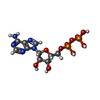 ChemComp-ADP: |
-Macromolecule #4: PHOSPHOAMINOPHOSPHONIC ACID-ADENYLATE ESTER
| Macromolecule | Name: PHOSPHOAMINOPHOSPHONIC ACID-ADENYLATE ESTER / type: ligand / ID: 4 / Number of copies: 2 / Formula: ANP |
|---|---|
| Molecular weight | Theoretical: 506.196 Da |
| Chemical component information |  ChemComp-ANP: |
-Experimental details
-Structure determination
| Method | cryo EM |
|---|---|
 Processing Processing | single particle reconstruction |
| Aggregation state | particle |
- Sample preparation
Sample preparation
| Buffer | pH: 7.5 Component:
| |||||||||||||||
|---|---|---|---|---|---|---|---|---|---|---|---|---|---|---|---|---|
| Vitrification | Cryogen name: ETHANE / Chamber humidity: 100 % / Chamber temperature: 277 K / Instrument: FEI VITROBOT MARK IV |
- Electron microscopy
Electron microscopy
| Microscope | TFS KRIOS |
|---|---|
| Image recording | Film or detector model: GATAN K3 (6k x 4k) / Average exposure time: 1.6 sec. / Average electron dose: 44.6 e/Å2 |
| Electron beam | Acceleration voltage: 300 kV / Electron source:  FIELD EMISSION GUN FIELD EMISSION GUN |
| Electron optics | Illumination mode: FLOOD BEAM / Imaging mode: BRIGHT FIELD / Nominal defocus max: 2.0 µm / Nominal defocus min: 0.5 µm |
| Experimental equipment |  Model: Titan Krios / Image courtesy: FEI Company |
 Movie
Movie Controller
Controller







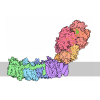

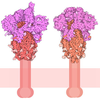






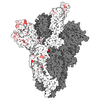
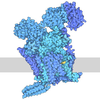
 Z (Sec.)
Z (Sec.) Y (Row.)
Y (Row.) X (Col.)
X (Col.)













